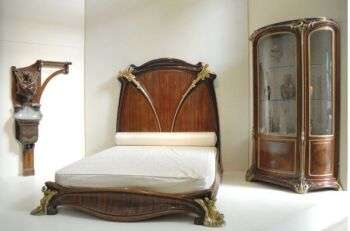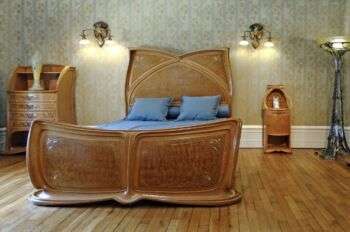French decorator and furniture designer Louis-Jean-Sylvester Majorelle was one of the greatest designers of Art Nouveau furniture.

Image source:https://en.wikipedia.org/wiki/Louis_Majorelle#/media/File:Louis_Majorelle.png
About His Life
Majorelle was a decorator, cabinetmaker, and manufacturer. Further, he was born in Toul, in 1859, to a family of furniture designers and manufacturers. Louis, in 1877, enrolled in the Paris School of Fine Arts. Two years later, his father died, and he had to return to Nancy, where he headed the family furniture factories with his brother.

Image source: https://search.creativecommons.org/photos/bc58fb89-7aea-445b-b59f-d32f01a40988 by dalbera
In 1894, Majorelle, inspired by naturalism and symbolism, created a completely new collection of furniture. His designs were notable for the use of inlay, and he was best known as a cabinetmaker. Further, he produced two main types of furniture: a collection of luxury furniture and a budget-friendly one. He launched the metal processing technology for the production of bronze. Additionally, itwas originally used to decorate furniture, and in 1896, in collaboration with Daum, lamps were launched. Then, he opened some retail stores, and, in 1901 he was appointed vice-president of the famous school of Nancy. After 1918, geometric shapes came to replace the floral ones, which symbolizes the arrival of the Art Deco style. Louis Majorelle died in 1926.

Image source: https://search.creativecommons.org/photos/6208aff3-6055-4deb-8d20-4d337dc290f4 by dalbera
Furniture Production
The French designer inherited his father’s furniture workshop, which specialized in luxurious Neo-Classical and Neo-Rococo pieces. From the 1890s, under Emile Gallé’s influence, Majorelle created a modern Art Nouveau style with elegant proportions and refined marquetries. Moreover, he was a master in the design of furniture using carving, inlay, and ormolu, or other metal decorative elements. In addition, the curving themes were generally based on floral patterns. He finds nature a key inspiration as well.

Image source: https://search.creativecommons.org/photos/36923fe1-2ebb-4103-b088-91c520c450a9 by dalbera

Image source: https://search.creativecommons.org/photos/d0aacfaa-c1c0-4de5-8a00-95f58db3a5da by dalbera
The work in Nancy is expansive in variety, originality, and beauty, although there is a tendency toward an excess of decorative richness. Majorelle’s style incorporated a modified flowing line with polished woods, highlighted by Art Nouveau bronze mounts in the 18th-century tradition. Further, his catalogs between 1900 and 1914 show a tremendous output, including suites of furniture for individual rooms, furniture using botanical motifs or other stylistic themes, and specific pieces whose prices ranged according to custom-ordered materials.

Image source: https://en.wikipedia.org/wiki/Louis_Majorelle#/media/File:Fauteuil_n%C3%A9nuphar.jpg
Info sources:
